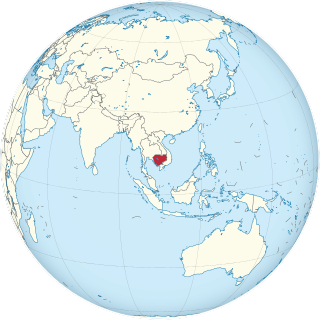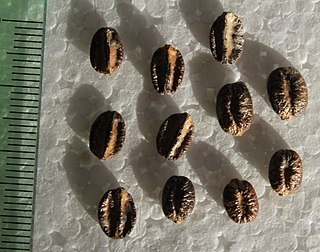
Cambodia is a country in mainland Southeast Asia. It borders Thailand, Laos, Vietnam, the Gulf of Thailand and covers a total area of approximately 181,035 km2 (69,898 sq mi). The country is situated in its entirety inside the tropical Indomalayan realm and the Indochina Time zone (ICT).
Natural resources are materials that occur in a natural form within environments. These can be classified as either biotic or abiotic on the basis of their origin. The landmass and the territorial waters of Cambodia contain a rather moderate amount, array and variety of resources. Apart from water, abiotic resources, such as minerals are generally rare. Still, advanced geo-scientific technologies have produced remarkable results and re-assessments in recent years, such as the localization of offshore oil and gas depots in the Gulf of Thailand. Cambodia, on the other hand possesses a relatively wide range of biotic resources, in particular timber, forest products, rare plants and a fauna of great diversity.
Ziziphus cambodiana is a deciduous thorny shrub, or vine, some 2–6 m tall, found growing in secondary undergrowth in Cambodia, Laos and Vietnam, and northern Thailand.

A small tree with tortuous twigs, Dillenia pentagyna is a member of the family Dilleniaceae, and is found from Sulawesi to South-Central China to India and Sri Lanka. Material from the tree has some minor uses.
Homalium dasyanthum is a tree or shrub in the family Salicaceae. It is found in Peninsular Malaysia, Thailand, Vietnam, Cambodia and Myanmar.
Hydnocarpus saigonensis is a tree in the Achariaceae family. It is endemic to the Mekong basin of Cambodia and southern Vietnam.
Terminalia cambodiana is a species of tree in the family Combretaceae, growing some 6–15 m tall with whitish-grey, exfoliating bark and large greenish branches. It is found in flooded forest communities of Cambodia and southern Vietnam.
Senegalia thailandica is a species of climbing or sprawling shrub in the family Fabaceae.
Dendrolobium baccatum is a species of flowering plants in the Fabaceae family. A shrub, it occurs in Mainland Southeast Asia. People use it for food and fuel.
Diospyros cambodiana is a tree in the Ebenaceae family, endemic to the Mekong basin, Cambodia. It grows some 15-20m tall in flooded/swamp forest. One of its vernacular names derives from the perceived likeness of its flowers to mouse droppings. The plant is used for construction, craftwork, firewood and medicine.
Combretum trifoliatum is a vine of the family Combretaceae. It is found from Myanmar across Southeast Asia and Wallacea to New Guinea and Australia. It grows in wet places, including where it can be submerged for four months a year by floodwaters. It is unusual in retaining its photosynthesizing leaves when flooded. Parts of the plant are used in traditional medicine.
Mallotus floribundus is a tree in the family Euphorbiaceae, in the Stylanthus section, native to Southeast Asia, Wallaceae, New Guinea and the Solomon Islands.
Memecylon caeruleum is a shrub or tree species in the Melastomataceae family. It is found from New Guinea, west through Southeast Asia to Tibet, Zhōngguó/China. It has become an invasive weed in the Seychelles. It has some local use for wood and food.
Pantadenia adenanthera is a shrub in the Euphorbiaceae family. It is found in parts of Southeast Asia. The species is used for its wood and edible fruit.
Samadera harmandiana is a freshwater mangrove shrub or small tree in the Simaroubaceae family. It is found in Cambodia, Laos and Vietnam. The wood provides firewood. Certain fish eat the poisonous fruit
Stixis obtusifolia is a shrub or liana in the Resedaceae family. It is found in parts of Southeast Asia. The wood is used as fuel, the leaves as a tea.

Xanthophyllum lanceatum is a tree in the Polygalaceae family. It grows across Southeast Asia from Sumatera to Bangladesh. The leaves are used as a hops-substitute in beer making and the wood as fuel. Fish in the Mekong regularly eat the fruit, flowers and leaves.

Aporosa octandra is a species of plant in the family Phyllanthaceae found from Queensland and New Guinea to Indonesia, Zhōngguó/China and India. It is a highly variable plant with 4 named varieties. Its wood is used in construction and to make implements, its fruit is edible. The Karbi people of Assam use the plant for dyeing, textile colours have quite some significance in their culture.

Ampelocissus martini is a species of climber or shrub in the Vitaceae family. Some sources use the spelling Ampelocissus martinii. It is native to an area of Mainland Southeast Asia. The fruit are eaten by people and by several species of Pangasiidae shark catfish of the Mekong river.
Memecylon lilacinum is a tree species in the Melastomataceae family. It is usually an understorey species in closed forests. It is native to an area of tropical Asia, from Jawa to Philippines to Vietnam and the Andaman Islands and Myanmar. It is a food plant for the macaque Macaca facsicularis and a bee in the Megachilidae family.




